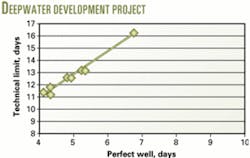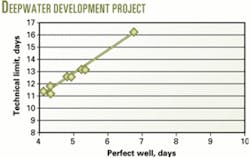How does the perfect well compare with the technical limit?
One Occidental partner routinely uses a technical-limit process to improve drilling performance in its deepwater operations. The approach has helped drilling teams identify and implement valuable improvements.
The perfect-well concept is not meant to replace an appropriately used technical-limit process because the perfect well identifies opportunities to improve, not how to improve.
An interesting question, however, is just how does an estimate of the perfect well compare with technical-limit estimates? The figure shows how the perfect-well time (estimated in less than 2 hr) compares with the estimate created with a technical-limit process on nine wells drilled over more than a year.
Variation in well depths and hole programs created significant differences in technical-limit estimates. The perfect-well analysis correlated almost perfectly (R2 = 97%) with the technical-limit estimates created by the team. Also, potentially significant, is that the "slope" of the fit is 1.87, quite close to the best-observed perfect-well ratio of 1.8. Essentially this means the technical-limit process used by this operation very nearly creates the empirically observed best perfect-well ratio from the more than 500 wells in the study. Estimating the perfect-well time takes about 1 hr, following a technical limit process can take the entire team days.
Clearly, knowing the perfect-well time is not the same as using a disciplined technical-limit process to identify and take action on improvements. It is significant, however, that the perfect-well time can quickly and easily create accurate estimates for technical-limit drilling times.

